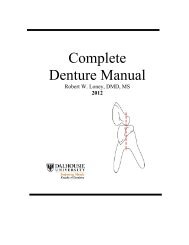RPD Manual 11 - Removable Prosthodontics - Dalhousie University
RPD Manual 11 - Removable Prosthodontics - Dalhousie University
RPD Manual 11 - Removable Prosthodontics - Dalhousie University
Create successful ePaper yourself
Turn your PDF publications into a flip-book with our unique Google optimized e-Paper software.
Framework Adjustment - 86<br />
3. Silicone impression materials or indicating medium (e.g. Fit Checker):<br />
These materials can also be used as three-dimensional indicators. A disadvantage<br />
of elastic materials is that they can tear or pull off the framework. In addition,<br />
time is required for set of the materials. In this regard the silicone fit-checking<br />
media are more useful since they have shorter working times.<br />
Use of Indicating Media<br />
1. Attempt to place framework intraorally. If gross resistance to placement is felt,<br />
remove and coat with indicating medium. If the framework seats, ask the patient<br />
if they feel the framework pulling on any teeth. The latter sensation will be<br />
caused by active engagement of abutment teeth. Inquire as to the overall comfort<br />
of the framework.<br />
2. Remove the framework and coat it with indicating medium. Align the<br />
framework over the abutment teeth and use finger pressure over rest seats along<br />
the path of insertion. DO NOT PLACE PRESSURE OVER GRIDWORK OF<br />
DISTAL EXTENSIONS as this will fulcrum the framework. If gross resistance<br />
to seating is encountered, remove and inspect for areas of burn-through. Have<br />
an instructor inspect the framework. Relieve areas of binding as indicated.<br />
Repeat until seating is achieved. The master cast can be inspected for areas of<br />
abrasion that may indicate areas of gross binding as well.<br />
3. Once the denture can be seated, coat with media and seat along the path of<br />
insertion again. Use firm even pressure over the rest seats and or indirect<br />
retainers. A mirror handle can be used for seating purposes. Use care in<br />
removing the framework, as removal along the wrong path of insertion will<br />
change the markings with displaceable media (wax & spray media).<br />
4. Use caution in adjusting the framework. The clinician must differentiate between<br />
normal and abnormal contacts. Guiding planes normally will exhibit long<br />
vertical areas of contact, but broad areas of complete burn-through may indicate a<br />
binding contact on the guiding plane. Similarly, the retentive tip of direct<br />
retainers will normally exhibit burn-through, but active clasp retention must be<br />
eliminated after the framework is fully seated. Therefore, the first step in<br />
adjustment is to ensure complete seating. The most common areas that<br />
interfere with seating are:<br />
1. under rests<br />
2. rigid portions of direct retainers (e.g. above the survey line)<br />
3. interproximal portions of linguoplate major connectors<br />
4. interproximal minor connectors<br />
5. shoulder areas of embrasure clasps<br />
Experience is required to differentiate between normal and excessive marking of<br />
the indicator medium. Therefore it is wise to consult with an instructor regarding<br />
proposed changes prior to adjustment. Adjustments can be made with small<br />
round diamond burs, white stones or rubber abrasive points, depending on the<br />
position and extent of binding. Do not use excessive force or the framework may















